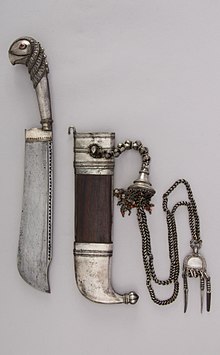Pichangatti: Difference between revisions
Rochelimit (talk | contribs) created |
(No difference)
|
Revision as of 15:08, 18 November 2017
| Pichangatti | |
|---|---|
 19th century pichangatti with its sheath. | |
| Type | Knife |
| Place of origin | Kodagu |
| Service history | |
| Used by | Kodava people |
| Specifications | |
| Mass | 0.28 kilograms (0.62 lb) |
| Length | 12 inches (30 cm) |
| Blade type | Single edge |
| Hilt type | silver |
| Scabbard/sheath | wood, silver |
| Head type | steel |
Pichangatti is a broad-bladed knife of the Kodavas of Karnataka, India. The characteristic of the pichangatti is its silver hilt with bulbous-shaped pommel in the shape of a parrot's head.[1] The pichangatti features in the traditional male dress of the Kodavas.
Origin

The name pichangatti is Tamil for "hand knife". Pichangatti is the knife of the Kodavas. The Kodavas (Kodava, Kannada) people inhabit the Kodagu region in southwestern India in what is now the state of Karnataka. The Kodavas have resided in the area for over 2 millennia. During the colonial period, the British referred to the region as Coorg, an anglicized corruption of "Kodagu", which is said to be derived from the Kannada word for "hilly" or "steep", referring to the geographical condition of the region.[2]
The Kodavas were known as fierce warriors. To protect their sovereignty, the Kodavas made their presence in battles against their neighbors, and later against the British Empire in 1834. In response to a riot near Malappuram in 1884, the British punished the region by confiscating the vast majority of the Kodava weapons, including the pichangatti. It was recorded that 17,295 weapons of which 7,503 were firearms were confiscated by the colonial British administration. Most of these were dumped to the sea, while the high quality examples can still be seen in what is now the Madras Museum.[2]
Form
Pichangatti has a broad, heavy, single-edged blade 7 inches (18 cm) long, and a plain hilt ending in a round pommel. The hilt and scabbard are profusely decorated with brass, silver or gold or of some two or three of these metals in very good style. Attached to the sheath is a brass, or silver chain, carrying tweezers, nail and ear cleaners, etc. The knife is always carried in the front of the belt that carries the ayudha katti. Probably one of the distinctive features of the pichangatti is its parrot-head shaped pommel. Very often the parrot's eyes are of uncut ruby. The hilt is often inlaid with silver. Sometimes the hilt is entirely made of ivory.[3]
The scabbard is made of wood (e.g. ebony) and with silver or brass mounting on it. Attached by a silver chain to the scabbard are usually five implements for cleaning e.g. a toothpick, a tweezers, ear-pick, piercer, and an articles to clean the nail. The pichangatti is not a weapon but more like today's pocket knife.[4]
See also
References
- ^ Gahir & Spencer 2006, p. 193.
- ^ a b Atkinson 2016.
- ^ Egerton 2002, p. 82.
- ^ Stone 2013, p. 497.
Cited works
- Egerton, Earl Wilbraham Egerton (2002). Indian and Oriental Arms and Armour. Dover: Courier Corporation. ISBN 9780486422299.
{{cite book}}: Invalid|ref=harv(help) - Gahir, Sunita; Spencer, Sharon, eds. (2006). Weapon - A Visual History of Arms and Armor. New York City: DK Publishing. ISBN 9780756622107.
{{cite book}}: CS1 maint: ref duplicates default (link) - Stone, George Cameron (2013). A Glossary of the Construction, Decoration and Use of Arms and Armor: in All Countries and in All Times. Dover: Courier Corporation. ISBN 9780486131290.
{{cite book}}: Invalid|ref=harv(help)
